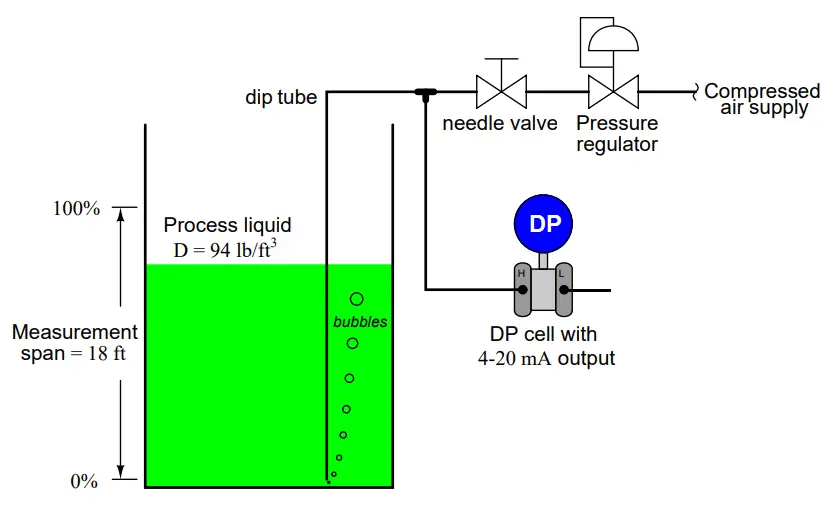A liquid storage vessel holding a very corrosive liquid has its level measured by a bubbler system, whereby a transmitter measures the backpressure of air inside a “dip tube” inserted into the vessel:

Explain how this level measurement system works, and how it protects the DP cell from the corrosive effects of the process liquid.
Also, complete a calibration table for the differential pressure transmitter in this level measurement scenario, with a calibration tolerance of ± 0.5%.
Assume that the lower range-value of the process (0% level) is exactly the same height as the bottom of the dip tube:
More Questions:
1. The dip tube (or “bubbler”) system does indeed isolate the transmitter from the corrosive process liquid, but how can the dip tube itself survive? And, if the dip tube is able to survive in the corrosive liquid (just like the vessel), why can’t we find a DP cell that can handle it directly without the isolation of a dip tube system?
2. Demonstrate how to estimate numerical answers for this problem without using a calculator.
3. What is your recommendation for setting the position of the needle valve in this bubble tube system? Exactly how far open is “open enough,” and more importantly for what reason?
4. What would happen if the end of the dip tube were to become plugged with debris, blocking all flow?
5. What would happen if the needle valve were to become plugged with debris, blocking all flow?
6. What would happen if the pressure regulator were to become plugged with debris, blocking all flow?
7. Add one or more hand valves to the tubing in this system to provide operators with a simple means of unblocking a plugged dip tube using high-pressure compressed air.
8. Given a 100% full vessel, calculate the amount of pressure that would be registered by a pressure gauge connected to the bottom of the vessel.
9. Given a 100% full vessel, calculate the amount of pressure that would be registered by a pressure gauge connected to the bottom of the dip tube.
10. Given a 100% full vessel, calculate the amount of pressure that would be registered by a pressure gauge connected to the transmitter’s “H” port.
11. Given a 100% full vessel, calculate the amount of pressure that would be registered by a pressure gauge connected to the downstream side of the needle valve.
12. Given a 100% full vessel, calculate the amount of pressure that would be registered by a pressure gauge connected to the upstream side of the needle valve.
Share your answers and explanation with us through the below comments section.
Read Next:
Credits: Tony R. Kuphaldt
The conveyor sorting machine is widely used in the packing industries using the PLC program…
Learn the example of flip-flop PLC program for lamps application using the ladder logic to…
In this article, you will learn the STAR DELTA programming using PLC controller to start…
Lube oil consoles of rotary equipment packages in industrial process plants are usually equipped with…
Rotating equipment packages such as pumps, compressors, turbines need the lube oil consoles for their…
This article explains how to blink lights in ladder logic with a detailed explanation video…